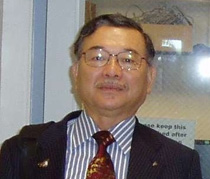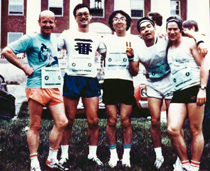Alumni News
Reconnecting with NIH Alumni
Staying in Touch With Fellows from Japan
A recent trip to Japan left me appreciating the rich experience that fellowships in the NIH intramural program provide for scientists from other countries and those of us who work with them. In particular, it got me thinking about the many Japanese fellows we hosted in the NIDR (now NIDCR) Laboratory of Developmental Biology and Anomalies (now the Laboratory of Cell and Developmental Biology).

Shigeto Abe
The lab hosted our first Japanese fellow, , in 1976 (through 1980). He was recommended to us by Professor Yutaka Nagai (Tokyo University, Tokyo), a pioneer in collagen and collagenase research. Shigeto had conducted his Ph.D. studies on the regulation of collagenase activity and studied its involvement in inflammatory joint disease.
At NIH, we were studying proteins produced by the mouse Engelbreth-Holm-Swarm (EHS) tumor, including collagen 4, laminin, and perlecan. Lance Liotta, then a member of the NCI Laboratory of Pathology, was working in our lab trying to clarify the mechanisms by which certain tumor cells degraded and invaded through basement membranes, a classic sign of malignancy. Shigeto joined the project (he and Lance shared a 200-square-foot research room), and they were able to show that collagenase (now known as MMP1) did not degrade collagen 4 and that malignant tumor cells produced a protease (now known as MMP2), which did.
On his return to Japan, Shigeto joined the Medical Corps of the Japanese Army, in which he rose to the rank of major general before retiring. Over the years, he has recommended Japanese fellows to us and us to them, including his own son (Yoshifura Abe) who did a fellowship at NIDDK with former NIDCR fellow Jeffrey Kopp two years ago.

The Japanese researchers who came to NIDCR were ready to join in lab activities whether they were research, soccer, or golf. Martin’s lab team (they called themselves the Ninjas) competed in the 1984 NIH relay race (left to right): George Martin; NIDCR fellows from Japan—Isao Ebihara, Kimitoshi Kohno, Yoshiki Sakurai; and postdoctoral fellow Kurt Doege who is now at Louisiana State University Health Sciences Center (in Shreveport). Shigeto Abe had already returned to Japan by then, but would have run had he still been at NIH.
Shigeto now heads up a medical clinic near Fukashima, Japan. I had the pleasure recently of visiting Shigeto and his family in Japan and meeting with some former NIDCR fellows. I was pleased, but not surprised, to find they had become leaders in research and medicine, including professors, heads of hospitals, presidents of university centers, department chairs, and high officials in Japanese pharmaceutical companies.
I think their success can be attributed in part to their solid training and hard work and in part to their experience living, collaborating, and socializing with the other 200-plus Japanese fellows while at the NIH. When their “class” returned to Japan, they knew many other researchers who would rise to the top of their fields. There are more than 2,000 members in the Japanese Society for the Promotion of Science U.S. Alumni Association. The organization even provides supports for U.S. citizens for short-term or long-term work in Japan. Kyoto, anybody?
This page was last updated on Friday, April 29, 2022
